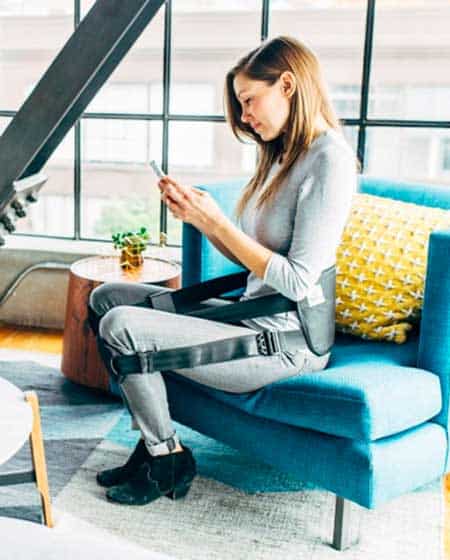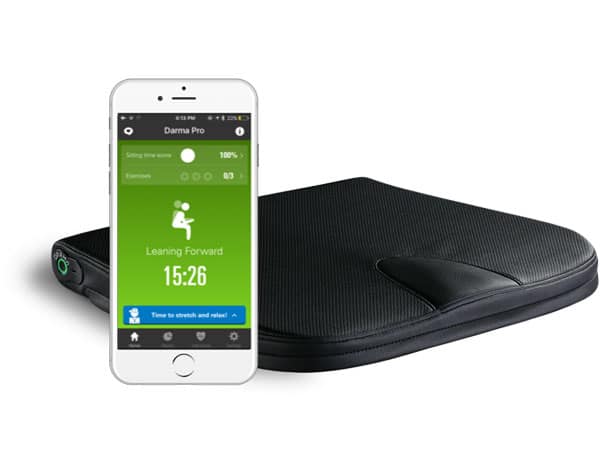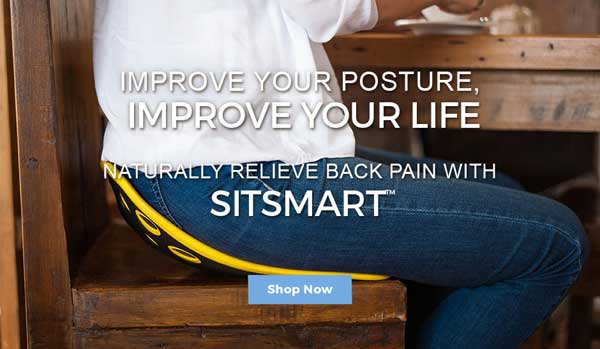They say that sitting is the smoking of the 21st century. Sitting down all day raises the risk of diabetes, obesity, cardiovascular problems, and even some kinds of cancer.
What’s more, often, we fail to sit up straight behind our computers and desks. Which takes an additional toll on our body manifesting in neck pain, back pain, knee pain, and tingling and numb hands and fingers.
The human body evolved to stand up or lie down, and sitting bends you into an unnatural position which can lead to joint and muscle pain in the long term.
As far as your body is concerned, the ideal solution would be to quit your desk job and go back to a hunter-gatherer lifestyle.
If that’s not an option, the next best thing is to make sure you’re seated with perfect posture, which will reduce strain on your body.
Once you’ve got into the habit of slumping, it can be tricky to hold good posture.
You start the day with head high and back straight, then as you get absorbed into your work you gradually drift back into your usual lopsided position. Seated posture correctors can help.
Some work by physically holding you in the correct position, while others use technology to give you a gentle reminder when you start to slouch.
Top 5 best seated posture correctors
BetterBack back support belt

Most back braces work by focusing on your lumbar spine (lower back), but having a straight back is no use if your pelvis is out of alignment.
The doctor-recommended BetterBack, featured on Shark Tank, has a low-tech but effective design: a broad piece of tough fabric sits against your lower back, with adjustable straps that hook over your knees.
This pulls your pelvis forward gently, automatically tugging your whole body into the correct position. You can use the straps separately (for example, if you like to sit cross-legged), or clip them together at the knees to hold your legs in the ideal position.
The straps also hold your shins at a tidy 90 degree angle, since they slip off your knees if you straighten your legs too much.
Users rave about how the simple design has zapped their lower-back pain and joint aches, and the results tend to be noticeable quickly.
Some people have complained that the straps get uncomfortable with extended wear; the company says this shouldn’t be an issue if you have the correct tightness.
The BetterBack is lightweight and portable (although the integral pocket is pretty small, so it takes a bit of stuffing and wiggling to get pack it away.)
Unlike other types of support, the BetterBack works on any seat as long as you can put your feet flat on the floor, so you don’t need to have one type of posture corrector for your desk chair and another for your sofa at home.
It takes just a few seconds to strap yourself into the BetterBack, although it might take you longer to get used to wearing it. You do have to take it off entirely in order to stand up, so it’s not the best choice for people who have to move around a lot at work.
Note that it only prevents you slouching backwards or to the side: if you tend to lean forwards while working, the BetterBack won’t stop you. Alternative harnesses and braces for better posture while seated are the Aider, VertiBack, and Got’urBack.
Darma smart cushion

The Darma smart cushion is filled with fiber-optic sensors, which are both thinner and more accurate than traditional pressure sensors. By linking the thin cushion to an Android app, you can monitor your breathing, heart rate, and posture.
The app doesn’t just point out your poor posture, it suggests stretching exercises which are tailored to counteract your particular style of slouch.
Most people know whether they tend to slouch forwards or backwards, but the Darma will even tell you whether you tend to lean slightly to the left or right. It will record your sitting time and send you a reminder when it’s time to stand up and walk around.
The cardiac monitor will plot your stress levels over time, so you can identify your most stressful periods.
- It will also send you a notification when your stress levels are too high, reminding you to take it easy: depending on how you handle pressure, that might be a helpful reminder or a cue to smash your phone against the wall in fury.
The Darma is unusual for a health monitoring device since it’s entirely non-intrusive: no wristband, brace, or clip-on sensor.
The battery needs to be charged for 8-10 hours at a time, but a single charge lasts for about a fortnight since the sensors automatically go to sleep when you’re not sitting on the cushion.
It’s easy to set up, and downloading the app will probably take longer than working out how to operate the cushion.
While the Darma is wireless and easy to move from one seat to another, it weighs 1.35kg and isn’t very portable.
It’s been designed for a firm-based office chair, and there’s a risk of buckling the sensors if you use it on a sofa or car seat. This means it’s most suitable for office workers who spend the majority of their time in one chair.
ALEX, Wearable posture tracker & coach
![]()
This Korean gadget is the only item on this list which will correct ‘tech neck’ as well as poor posture. Tech neck (or text neck) is discomfort caused by spending hours staring down at a smartphone or hunching over a computer.
Alex Posture looks like a pair of behind-the-ear headphones, with two adjustable arms which you clip to each side of the back of your head. Sensors track your position, whether you’re bending your head or leaning your whole torso.
Although it makes you look a little like an android, the headset is light and fairly unobtrusive, and it can be easily hidden under long hair.
This headset links to an app which allows you to set your own posture goals, and track your posture over days so you can see your improvement over time. You can set it to notify you when you lean beyond a certain angle, and also decide how long you need to hold bad posture before it sends a notification.
It works whether you’re standing or sitting. Notification is via a message to your phone, with a cute little avatar which illustrates your degree of slouch.
Unfortunately, there’s no real-time feedback (like vibrate mode) available from the headset, so you’ll have to keep your phone on top of your desk to use Alex: a potential productivity killer.
Lumo Lift
![]()
The Lumo Lift is an activity tracker with a posture monitor, which uses magnets to clip to your clothing. In addition to tracking distance, steps, and calories burned, it will also track your posture over time and vibrate gently when you start to slump – this is known as coach mode.
You can set the timings for coach mode, giving you anything from 3 seconds to 10 minutes’ grace before you’re reminded to correct your posture.
The default time is 2 minutes, long enough that you can lean forward to pick up your coffee cup without getting buzzed. If you’re doing something active and the reminders start to get on your nerves, then pressing the Lumo through your clothes for 3 seconds will instantly switch off coach mode.
Most posture correctors work by supporting the back and physically tilting your body into the correct position, but by reminding you to sit up straight the Lumo trains you to sit better on your own.
This means that not only are you improving your sitting posture, but you’re building up the core muscles which hold your body in alignment.
The monitor is small and unobtrusive, looking like a square shirt pin, and the magnets are tough enough to stop it getting knocked off; there’s also a bra-strap clasp option. The buzz is strong enough that you can feel it but not noticeable to onlookers.
Battery life varies with use: it can last for up to 5 days, although coach mode drains a lot of power. It’s sweat-resistant but not totally waterproof, so it’s fine to wear for a brisk walk but not a sweaty Bikram session.
The Lumo is a genius idea, but some of the technology lets it down. The gadget will give you a malfunction message if you set it up wrongly; since the manual is pretty thin on detail, it’s hard to avoid making mistakes with the setup.
It works automatically with the app, but to use it with a PC you’ll need to buy a special Bluetooth dongle. Users have reported problems with the app, and the recording can be inconsistent.
Some users have found that it fails to register a slump, or records inaccurate wearing times. The sensitivity is about 5o, which means it’s great at recognizing when you lean forwards, but if you tend to hunch or slump your shoulders then it may not recognize this vertical movement.
Purchase.
BackJoy SitSmart

This is probably the most low-tech item on the list, but it’s cleverly designed. The SitSmart is a seat topper moulded to the shape of your gluteus muscles.
You prop this scoop-shaped cushion onto the back of your seat, and when you sit down it tilts your hips into a neutral position and supports your pelvis.
It’s the closest you can get to squatting like a caveman while still in your seat. Since it’s so thin, it doesn’t add any height to the chair, making it great to use while driving since you won’t have to readjust your seat height.
The basic SitSmart is made from waterproof EVA foam, tough enough to hold its shape but not so stiff that it digs in at the edges, with holes for breathability.
While it looks uncomfortably hard, you’ll find that when you’re sitting correctly you don’t need a squashy cushion under you.
Since your tailbone is lifted above the surface of the seat, there’s less pressure on your body. There are also more deluxe versions available, with cushioning or gel memory foam for extra comfort.
The SitSmart can be used on any type of chair, from a squashy sofa to baseball bleachers. However, the softer models are more suitable for use on harder seats, and vice versa, so you’ll need to read online reviews to decide which model is best for you.
- It’s suitable for anyone up to 300lbs; the Mini version holds up to 120lbs, perfect for kids or small-framed adults.
It takes a bit of practice to get the correct position on the SitSmart, and if you get the wrong position you’ll feel like you’re wobbling around in your seat. It can’t be fixed to the chair so you’ll have to readjust it every time you get up, which can be a bit of a pain if you’re in and out of your seat a lot.
Once you’ve got used to it, you’ll find that the SitSmart engages your abs as well as aligns your back.
Think one of these gadgets can fix your seated posture?
Drop you comments or questions below.
You may also like:
17 Best Active Sitting Chairs For Better Posture, Productivity And Health
References
Why sitting too much is bad for your health: NHS.
Tech neck: Spine Universe.
Last Updated on May 5, 2020 by Tyler
